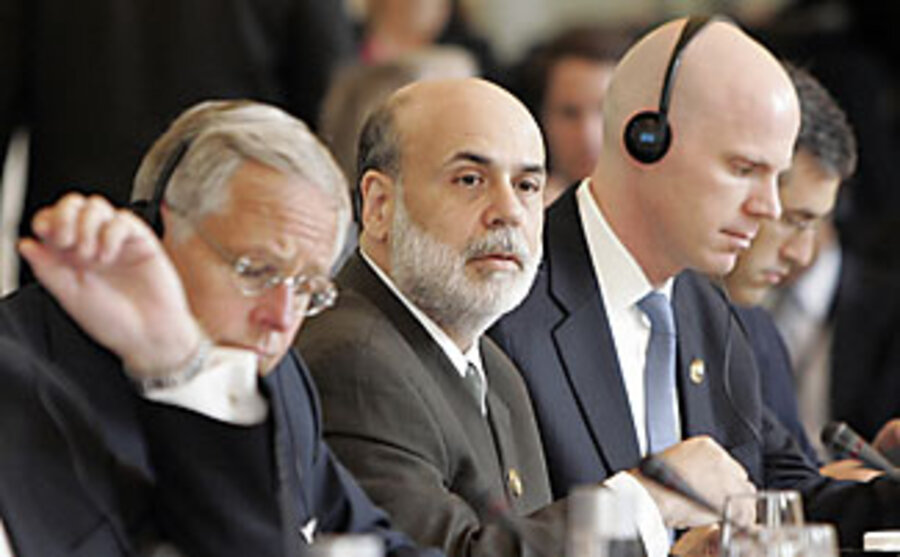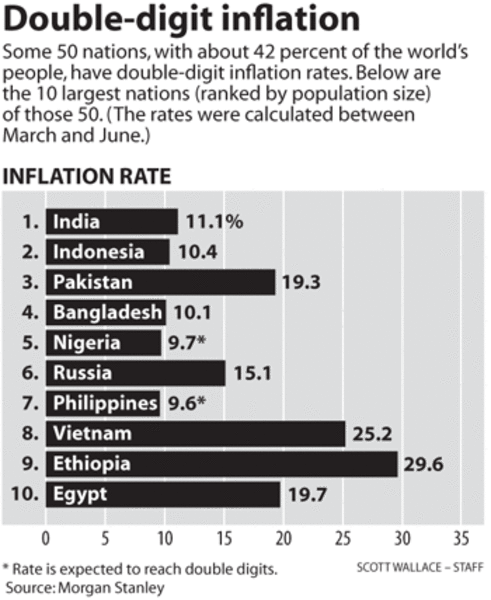A global war on inflation
With inflation a rising threat, nations around the world are trying to navigate a delicate task: containing that price pressure even as the linchpin US economy reels from the opposite challenge of a credit bust.
If all goes well, the global economy will muddle through.
But signs of how difficult this will be are all around. Rising unemployment in America, for example, shows that the risk of recession is real – and could potentially spread worldwide.
Global inflation is growing harder to ignore. Oil, which has become the main symbol of global inflation, traded at a new record Monday. And European inflation has reached highs never seen under the euro currency. By one new survey, 3 billion people – 42 percent of the world's population – are experiencing double-digit annual rises in consumer prices.
That's why many nations have begun to tighten their credit reins in an effort to curb inflation. This Thursday, forecasters expect the European Central Bank to join the battle by raising its interest rate. Sweden and Indonesia may do the same that day. Even the US Federal Reserve has been forced to consider a tighter policy.
"It's conceivable that the synchronized tightening by all these emerging economies and the European Central Bank [could] cause a global recession, which would bring oil prices down," says Ed Yardeni, an economist who heads Yardeni Research in Great Neck, N.Y.
For their part, central bankers are hoping to contain oil prices without causing a slump.
Mr. Yardeni predicts the world economy will trudge through the mess, with recession confined mainly to the American economy.
About the only thing economists see eye to eye on these days is that the path forward is lined with more challenges and uncertainties than a year ago.
On Monday, the Bank for International Settlements in Basel, Switzerland, sounded a cautionary note in its annual report.
"In the aftermath of a long credit-driven boom, it would not be surprising to see turmoil in financial markets, slowing real growth, and temporarily rising inflation," the report said. That mix "does appear to point to a deeper and more protracted global downturn than the consensus view seems to expect."
In this environment, a crucial question is: How many nations need to tighten monetary policy, and by how much?
Conflicting analyses
Some economists worry that the world's central banks have not yet awakened to the magnitude of the inflationary threat. Others say that the interest-rate moves under way, and those likely in the months ahead, will bring prices under control, assisted by the general weakening of economic growth.
Where the two sides agree is that monetary policy worldwide has been generally loose – and that this has been a major factor propelling fuel and food prices.
"However you want to measure … it's quite clear that monetary policy is very stimulative," says Nariman Behravesh, chief economist at Global Insight, a forecasting firm in Lexington, Mass.
For the first time, he says, an oil spike is being caused by rising demand in emerging-market nations. Many forecasters had expected that oil prices would retreat alongside slumping US demand, as had happened in the past.
This puts developing nations, and their central banks, in an important position in the current cycle.
"In the end, I think a lot of this has to fall on the emerging markets," Mr. Behravesh says. "They not only need to rein in their money-supply growth, but they also need to remove their subsidies" on energy use, he explains. Both policies have been inflationary.
From South Africa to India, many central banks have already raised interest rates. And some nations have reduced subsidies to consumers – including a major move by China recently.
Many nations are wary of changing policies too fast, given the risk of social instability as well as recession. But failing to act could also trigger a near-term slump – or an inflationary spiral that inflicts even greater damage on world economic growth.
Economists at investment bank Morgan Stanley found that about 50 nations show consumer prices up 10 percent or more from a year ago.
They warn that some central banks feel constrained, because they are focused on maintaining currency exchange rates against the US dollar. A weak dollar has caused loose monetary policy in nations with such "dollar-pegged" currencies.
Printing more currency
Central banks in these nations have to print more of their own currency to buy US dollars to hold exchange rates steady, explains Paul Kasriel, an economist at the Northern Trust Co. in Chicago. "That's not the only factor working here, but that is a factor," he says.
This is one reason that the Federal Reserve faces greater pressure to consider raising interest rates, even though the Fed has until recently been cutting rates to help the US economy out of a slump.
Mr. Kasriel says that other nations, not the Fed, should take the lead in fighting inflation. His reasoning: Even though the Fed's short-term interest rate is very low, at 2 percent, that doesn't mean that Fed policy is currently stimulative. Because of the economy's slowdown, the US money supply has actually been shrinking lately – and so has bank credit, a broader measure of the monetary situation.
"This is a full-blown credit crunch" domestically, Kasriel says, not an inflationary situation.
"If the Federal Reserve were to raise interest rates [now], that would send the economy into a deep recession," he says. But "it has to pay lip service to inflation."






